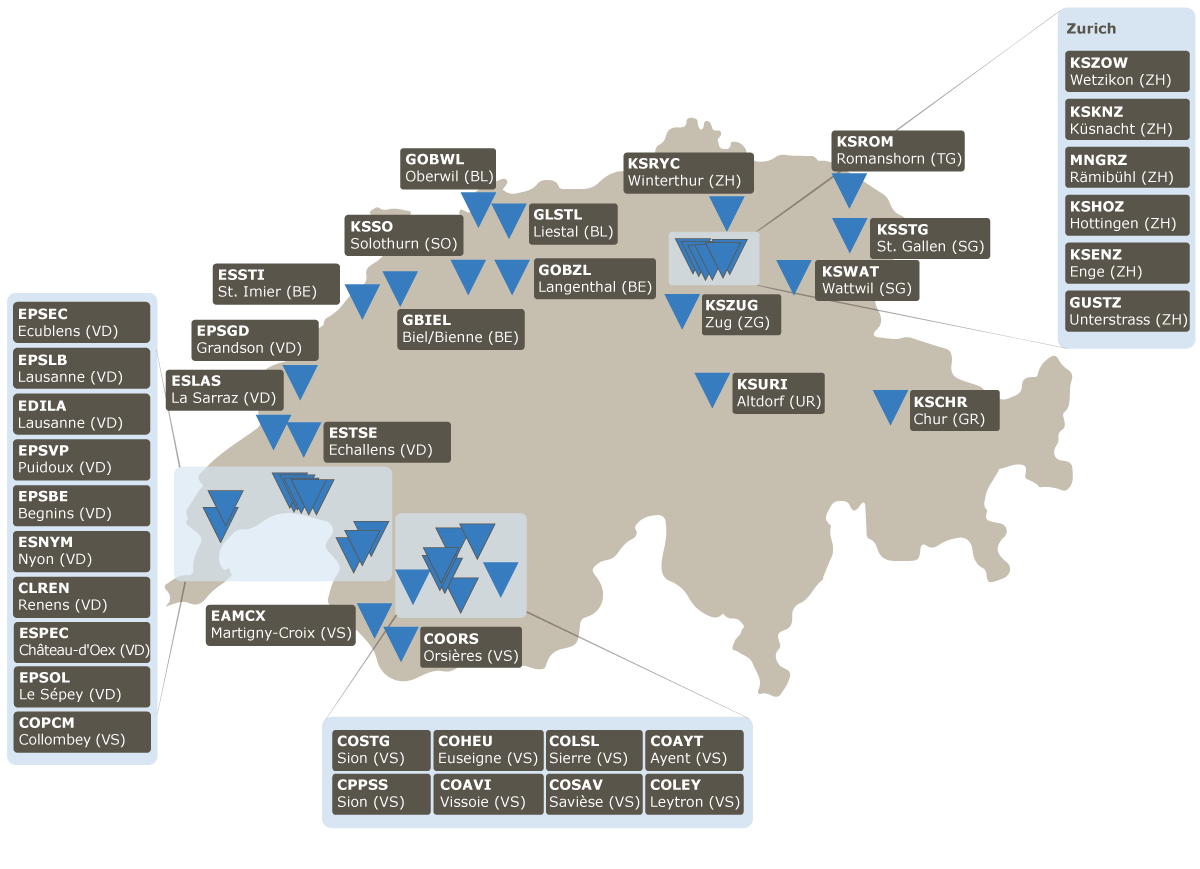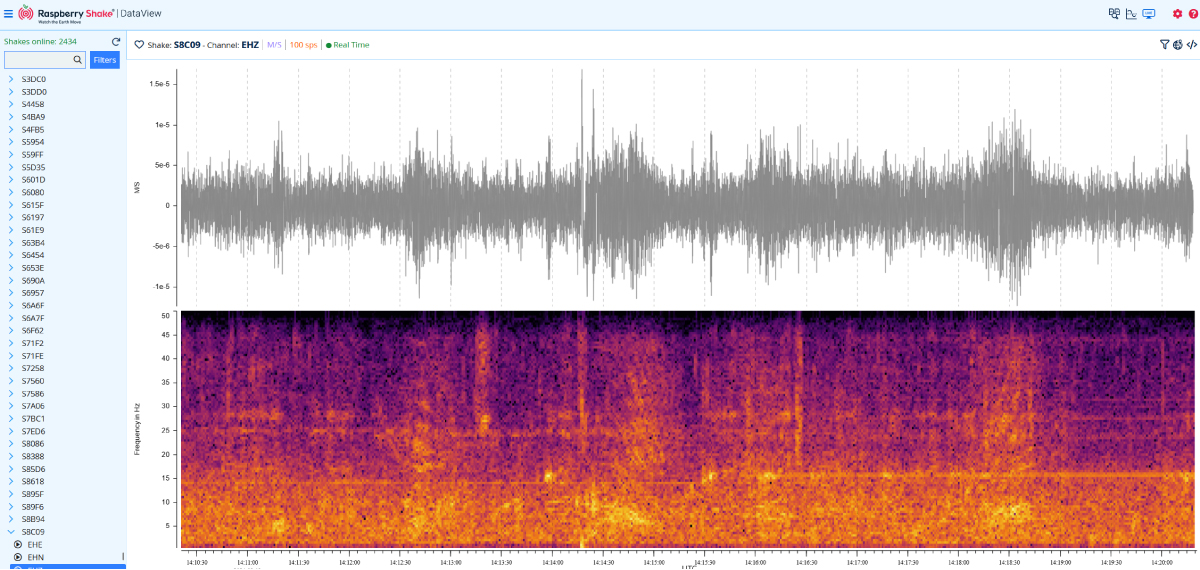Numerous high schools and cantonal schools in Switzerland are equipped with a RaspberryShake seismometer, which can be used to continuously record the earth's movements. These devices record earthquakes in Switzerland and worldwide. The seismic data from more than 2,000 sensors worldwide can be accessed via the RaspberryShake website. The user-friendly processing of the data makes it easy to determine the epicentre of an earthquake in school lessons, for example, or to investigate other questions in a practical way.

List of RaspberryShake school seismometers in Switzerland
| SED station name |
RaspberryShake station name |
Place |
| GBIEL | S8C09 |
Gymnasium Biel-Seeland Biel |
| GLSTL | RDFB5 |
Gymnasium Liestal |
| GOBZL | R19BB |
Gymnasium Oberaargau |
| GUSTZ | R4335 |
Gymnasium Unterstrass |
| KSCHR | RB22F |
Bündner Kantonsschule Chur |
| KSENZ | RD3C4 |
Kantonsschule Enge Zürich |
| KSHOZ | RE5E7 |
Kantonsschule Hottingen Zürich |
| KSKNZ | RC23B |
Kantonsschule Küsnacht |
| GOBWL | RDFB5 |
Gymnasium Oberwil |
| KSROM | R58D2 |
Kantonsschule Romanshorn |
| KSRYC | RF726 |
Kantonsschule Rychenberg, Winterthur |
| KSSO | RFE6B |
Kantonsschule Solothurn |
| KSURI | R8F49 |
Kantonsschule Uri |
| KSWAT | R4AF0 |
Kantonsschule Wattwil |
| KSZOW | RF726 |
Kantonsschule Zürcher Oberland, Wetzikon |
| KSZUG | R3BE0 |
Kantonsschule Zug |
| MNGRZ | R7DBB |
Mathematisch-Naturwissenschaftliches Gymnasium Rämibühl |
| KSSTG | R103E |
Kantonsschule St. Gallen |
| COAVI | RA652 (currently unavailable) |
CO d'Anniviers |
| COAYT | RB15C |
CO Ayent |
| CLREN | R3BDC |
Collège du Léman |
| COHEU | RB289 |
CO Hérens |
| COLEY | RA7C7 |
CO Leytron |
| COLSL | RE4EF |
CO des Liddes |
| COORS | S3900 (currently unavailable) |
CO Orsières |
| COPCM | RA83F |
CO des Perraires |
| COSAV | R2D50 |
CO Savièse |
| COSTG | R7694 |
CO St-Guérin |
| CPPSS | R05D6 |
SION CPPS HES-SO (Partner Institution) |
| EAMCX | S7A06 |
Ecole de l'Arpille |
| EDILA | RC676 |
EDI LAUSANNE (Partner Institution) |
| EPSBE | R65E9 |
EPS de Begnins – L'Esplanade |
| EPSEC | R8710 |
EPS Ecublens |
| EPSGD | R3B57 |
EPS Grandson |
| EPSLB | R0CD2 (currently unavailable) |
EPS Bergières |
| EPSLE | R5BF0 |
Collège/EPS de l'Elysée |
| EPSVP | RF727 |
EPSCL Collège du Verney |
| ESLAS | R8E4D |
ES de La Sarraz et environs |
| ESNYM | R5D35 (currently unavailable) |
ES Nyon-Marens |
| ESPEC | R46E5 |
ES du Pays-d’Enhaut* |
| ESTSE | R52F7 (currently unavailable) |
ES des Trois-Sapins |
| ESSTI | R1F5E |
ES St-Imier |
| EPSOL | RE4DE |
EPS Les Ormonts-Leysin |
Go to the RaspberryShake website and click on "Station View." You should now see a map with all publicly accessible RaspberryShake stations worldwide. In the menu at the top of the website under "Stations," enter the name of a RaspberryShake (e.g., S8C09) and confirm your entry by clicking on the station name. You should now see your RaspberryShake on the map. On the right side of the browser window, you can see the ground vibrations, specifically the ground velocity, that your RaspberryShake is currently recording (with a slight delay).
To enlarge the recordings, click the icon next to "Live Streaming". A new window will open. The upper part of the window shows the seismogram, and the lower part shows the spectrogram. Seismograms and spectrograms show how ground movements and the frequencies of these movements change over time. The time axis runs from left to right. By clicking on the time axis, you can switch between UTC (Coordinated Universal Time) and local time in Switzerland (Central European Summer/Winter Time). The frequency measures the number of (ground) oscillations per second. The faster the ground moves up and down or back and forth, the higher the frequency. Frequencies that are particularly excited are highlighted in bright colors in the spectrogram. In the example below, frequencies of around 15 Hertz (Hz), i.e., 15 oscillations per second, were particularly excited between 13:52:30 and 13:58:30. You can clearly see this as a horizontal line in the spectrogram.

Example: ‘Live streaming’ of station S8C09 in the web browser. In the right-hand column you can see the seismogram at the top and the spectrogram below. The time axis (here UTC) runs from left to right. The left-hand column shows the list of all available Raspberry shakes, from which you can select one.
RaspberryShake data Switzerland
Data access: RaspberryShake
- ShakeNet App, Mobile App
- Station map, web app: station view
- Seismogramme, web app: data view
- Localisation through triangulation, Webapp: Locator
- Vertonung von Seismogrammen, Web App (Account erforderlich): Sound